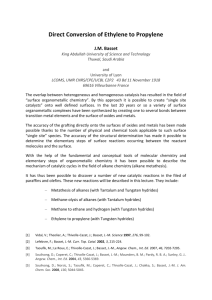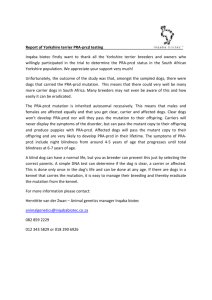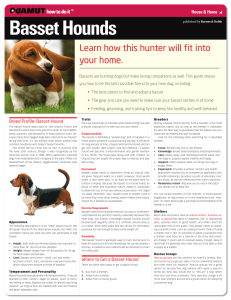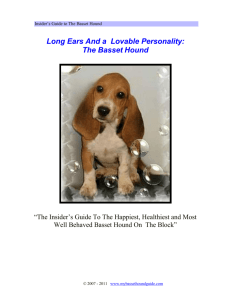Basset Hound Thrombopathia Mary K. Boudreaux, DVM, PhD
advertisement
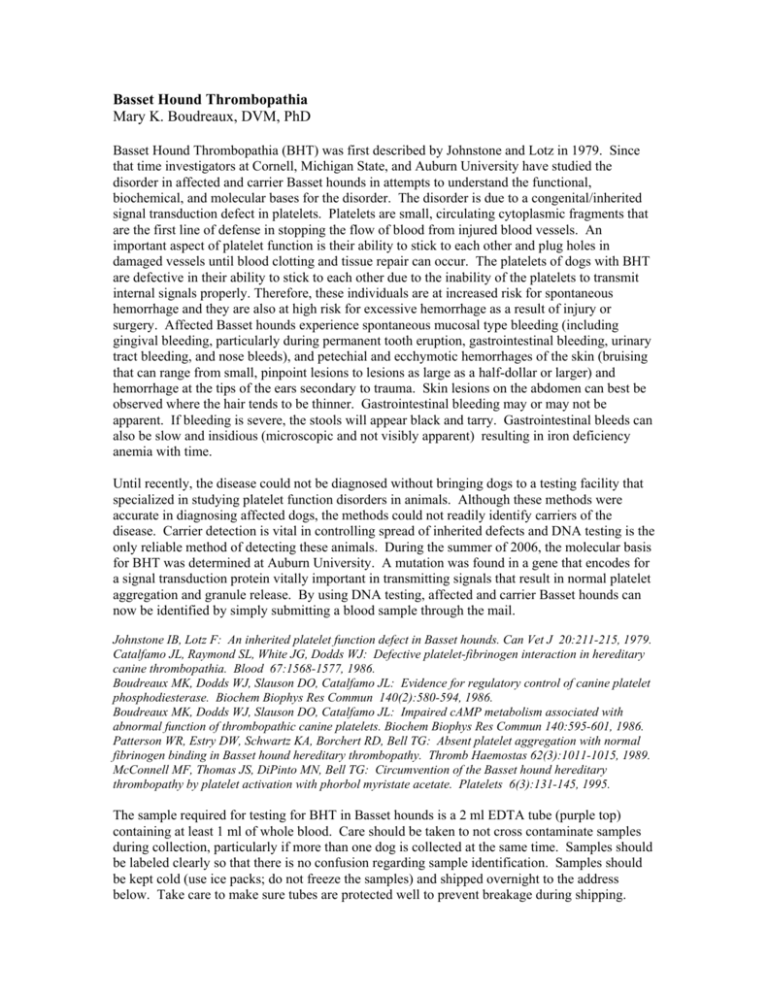
Basset Hound Thrombopathia Mary K. Boudreaux, DVM, PhD Basset Hound Thrombopathia (BHT) was first described by Johnstone and Lotz in 1979. Since that time investigators at Cornell, Michigan State, and Auburn University have studied the disorder in affected and carrier Basset hounds in attempts to understand the functional, biochemical, and molecular bases for the disorder. The disorder is due to a congenital/inherited signal transduction defect in platelets. Platelets are small, circulating cytoplasmic fragments that are the first line of defense in stopping the flow of blood from injured blood vessels. An important aspect of platelet function is their ability to stick to each other and plug holes in damaged vessels until blood clotting and tissue repair can occur. The platelets of dogs with BHT are defective in their ability to stick to each other due to the inability of the platelets to transmit internal signals properly. Therefore, these individuals are at increased risk for spontaneous hemorrhage and they are also at high risk for excessive hemorrhage as a result of injury or surgery. Affected Basset hounds experience spontaneous mucosal type bleeding (including gingival bleeding, particularly during permanent tooth eruption, gastrointestinal bleeding, urinary tract bleeding, and nose bleeds), and petechial and ecchymotic hemorrhages of the skin (bruising that can range from small, pinpoint lesions to lesions as large as a half-dollar or larger) and hemorrhage at the tips of the ears secondary to trauma. Skin lesions on the abdomen can best be observed where the hair tends to be thinner. Gastrointestinal bleeding may or may not be apparent. If bleeding is severe, the stools will appear black and tarry. Gastrointestinal bleeds can also be slow and insidious (microscopic and not visibly apparent) resulting in iron deficiency anemia with time. Until recently, the disease could not be diagnosed without bringing dogs to a testing facility that specialized in studying platelet function disorders in animals. Although these methods were accurate in diagnosing affected dogs, the methods could not readily identify carriers of the disease. Carrier detection is vital in controlling spread of inherited defects and DNA testing is the only reliable method of detecting these animals. During the summer of 2006, the molecular basis for BHT was determined at Auburn University. A mutation was found in a gene that encodes for a signal transduction protein vitally important in transmitting signals that result in normal platelet aggregation and granule release. By using DNA testing, affected and carrier Basset hounds can now be identified by simply submitting a blood sample through the mail. Johnstone IB, Lotz F: An inherited platelet function defect in Basset hounds. Can Vet J 20:211-215, 1979. Catalfamo JL, Raymond SL, White JG, Dodds WJ: Defective platelet-fibrinogen interaction in hereditary canine thrombopathia. Blood 67:1568-1577, 1986. Boudreaux MK, Dodds WJ, Slauson DO, Catalfamo JL: Evidence for regulatory control of canine platelet phosphodiesterase. Biochem Biophys Res Commun 140(2):580-594, 1986. Boudreaux MK, Dodds WJ, Slauson DO, Catalfamo JL: Impaired cAMP metabolism associated with abnormal function of thrombopathic canine platelets. Biochem Biophys Res Commun 140:595-601, 1986. Patterson WR, Estry DW, Schwartz KA, Borchert RD, Bell TG: Absent platelet aggregation with normal fibrinogen binding in Basset hound hereditary thrombopathy. Thromb Haemostas 62(3):1011-1015, 1989. McConnell MF, Thomas JS, DiPinto MN, Bell TG: Circumvention of the Basset hound hereditary thrombopathy by platelet activation with phorbol myristate acetate. Platelets 6(3):131-145, 1995. The sample required for testing for BHT in Basset hounds is a 2 ml EDTA tube (purple top) containing at least 1 ml of whole blood. Care should be taken to not cross contaminate samples during collection, particularly if more than one dog is collected at the same time. Samples should be labeled clearly so that there is no confusion regarding sample identification. Samples should be kept cold (use ice packs; do not freeze the samples) and shipped overnight to the address below. Take care to make sure tubes are protected well to prevent breakage during shipping. Please do not ship on Friday or the day before a holiday. The fee for testing is $100 per sample. Make checks payable to: Auburn University, Department of Pathobiology. Please provide the following information on each dog being tested: Name and AKC Registration Number Male or Female (Circle one) Age at time of sampling or Date of Birth AKC Registration Number of Sire AKC Registration Number of Dam I am hereby requesting this sample be tested for the mutation described as causing Basset Hound Thrombopathia in Basset Hounds. I understand that my individual test results will only be released to me. I certify that I am the owner of this dog. I understand and agree that the results of this test may be confidentially combined with those of other owners and used in aggregate result form for research purposes including publication. I understand in aggregate result form my individual results will not be identifiable specifically to my dog. I release Dr. Boudreaux and any associates working with her and Auburn University from all liability regarding this sample. Owner’s Signature Date Owner’s Name (print clearly or type) Telephone number Address Results should be sent to: Send samples to: Mary K. Boudreaux, DVM, PhD Department of Pathobiology 166 Greene Hall College of Veterinary Medicine Auburn University, Alabama 36849-5519 (334) 844-2692 Now that we can definitively identify carriers of Basset Hound Thrombopathia I think we all need to make sure that we understand how to handle/deal with this information. Most of you have spent a good part of your lives trying to advance the quality of the breed and as a result have produced some spectacular Bassets. What you don’t want to do is throw all of that effort away because one of those dogs happens to carry a mutation for Thrombopathia. Dogs should still be bred with the goal of producing great Bassets. If a really great Basset is also a carrier for the mutation, then go ahead and breed but make sure to breed to a clear Basset. (I do NOT recommend breeding two known carriers). Breeding a carrier to a clear will statistically produce a 50:50 litter (50% carriers and 50% clear, understanding that I have seen it be 80:20 and 20:80 so the dice are not always kind) that you can hopefully select clear dogs from to continue your line with. The puppies from such a litter should all be tested for the mutation to identify who the carriers are. If you breed two clear bassets you don’t have to test the litter. At this point in time we don’t know how prevalent this mutation is in the breed. I am worried it is very prevalent because it has been around for so long without having a good way of identifying it. What I hope does not happen is that people will decide to shut down their lines and stop breeding. That would be tragic, especially if the line has other great qualities that would benefit the breed. You can avoid narrowing the gene pool by being intelligent about how you approach this. I also hope people don’t take this as an opportunity to point fingers and get angry. The only breeders I would wonder about would be the ones who knew they had carriers (had produced affected pups) and yet continued to breed in out-crosses to prevent producing more affected pups but as a consequence spread the mutation around. I would have a hard time understanding why someone would do that and hopefully no one did. I think most breeders simply did not know they had Thrombopathia in their lines and if they did, they truly did not know where it was. As far as what dogs should be tested, I think the obvious answer is dogs who are being used for breeding purposes. Once a sire and dam have been identified as clear, their litters do not have to be tested. Any breeding that involves a carrier should have the litter tested, particularly if puppies from that litter will be used to breed. If puppies are all placed in homes as pets and are under contract to be spayed/castrated, then these puppies probably don’t need to be tested. What about another mutation? This does worry me because it is possible down the line that another mutation could occur and we have no way of monitoring for this. I described a platelet disorder in Eskimo Spitz dogs in 1994. When platelet function studies were performed, the affected Spitz platelet function looked just like Basset Hound Thrombopathia. If I hadn’t drawn the sample myself, I would have sworn someone was trying to play tricks on me. Anyway, the Spitz mutation is in the same gene that causes Basset Hound Thrombopathia (different mutation but same gene) so it is clear that this gene tends to mutate and it is not inconceivable that another mutation could occur in Bassets or another breed. Breeders need to speak up immediately if they produce an affected pup after the breeding of two clear Bassets. It is cost prohibitive to evaluate the entire gene on every dog that a sample is submitted on; we will be focusing on where we know the mutation is on the samples we get. If we become aware that there may be another mutation, then we can immediately scan the entire gene in the dog in question. The good thing is that at least we now know where to look.
